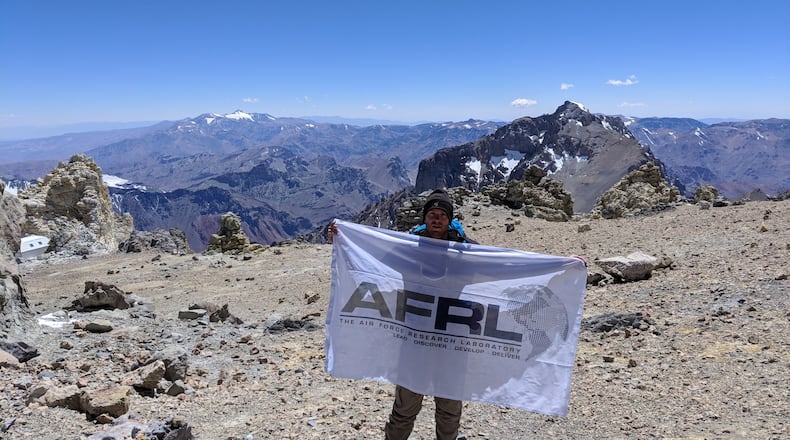Schmidt, 28, a research engineering psychologist at the 711th Human Performance Wing at Wright-Patterson Air Force Base, was thousands of feet up on a climb of Mount Aconcagua to learn more about the effects of hypoxia, or lack of oxygen at high altitudes, on humans’ ability to think and perform.
RELATED: Air Force Marathon launches sign up for 2018 races
The winds “were pretty hostile,” Schmidt said in a recent telephone interview from Santiago, Chile. “We met a lot of other people on the mountain and we were all climbing together and my tent wasn’t the only one to rip open. It’s pretty crazy.
“I had to rely on other people on the mountain,” he added. “Actually, it was an incredible show of humanity. … You just instantly have this bond when you’re in hostile environments that everyone is just trying to get through it together.”
The summit to Mount Aconcagua, at about 22,800 feet, is the highest point in the Western Hemisphere. He made it to just under 20,000 feet when the decision was made to return to base camp because the dangerous winds persisted on the final day of the ascent.
“The biggest thing that I learned about this mountaineering stuff is the mountain lets you summit,” he said. “You can’t plan everything. I usually like to have everything spelled out and no matter how much training we do … how much working out we do, how much our bodies are ready for this, you’re always at the will of the mountain.
RELATED: ‘Chilly Willy’ lands at Wright-Patt, will be used for research
“You learn that quickly when 80 mile-an-hour winds or whatever rips your tent apart and you’re stuck there without shelter,” the Ohio native added. “That was the big take home for me.”
The research, which was not sponsored by AFRL, was to determine how to better train for high-altitude environments and how the mind and body are affected in low oxygen environments. He was on the mountain for nine days last month, and was scheduled this week to climb the Cascade Mountains in Washington state for more research.
“You can feasibly see situations in a cockpit where having better performance in these low oxygen environments might really be lifesaving,” Schmidt said.
He used AFRL-developed technology to make the trek in South America, he said. The gear included BATDOK (Battlefield Airmen Trauma Distributed Observation Kit), which transmits vital data on how the body is performing to a wearable or a small wireless computer; GPS smart watches from an exercise and physiology lab called Signature Tracking for Optimal Nutrition and Training; and a battery of cognitive tests from the Biophysiology of Stress Laboratory. The facilties are within AFRL.
RELATED: AFRL researchers hunt for clues in F-35 stealth fighter issue
Schmidt, who planted an AFRL flag when he climbed Mount Kilimanjaro in Africa, prepared for this latest ascent spending three-hour sessions on a Stairmaster with 70-pound backpacks, running and bike rides, according to AFRL.
The Air Force researcher and Wright State University graduate started a five-year program this fall to earn a doctoral degree to study brain behavior and cognition in the psychology department at Northwestern University near Chicago. He’s enrolled in a Department of Defense program called Science, Mathematics and Research for Transformation (SMART).
Through SMART, he also earned a master’s degree in a neuroscience program at George Mason University in Fairfax, Va.
“I’m in school to develop my skills so once I graduate I can start doing formal work for the Air Force again trying to develop these technologies for the Air Force,” he said.
About the Author
